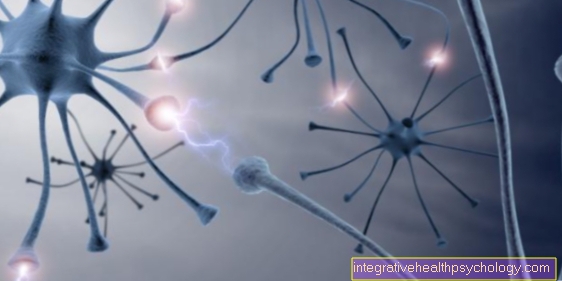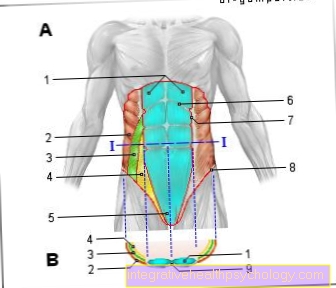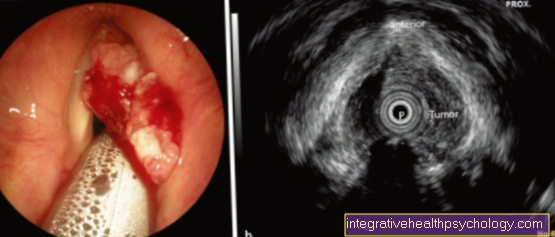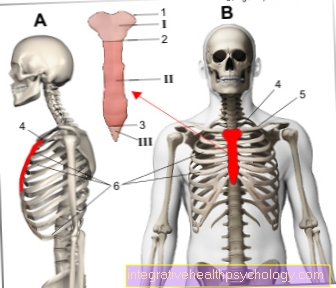The pupillary reflex
What is the pupillary reflex?
The pupillary reflex describes the involuntary adjustment of the eye to changing light conditions. The width of the pupil changes reflexively with incident light.
- If the environment is very bright, the light stimulus is correspondingly high and the pupil diameter is reduced (miosis).
- If the light stimulus is small, i.e. in dark conditions, the pupil dilates (mydriasis).
This reflex is controlled by the parasympathetic nervous system and plays an important role in visual acuity and in protecting the retina.
You may also be interested in the following article: Retina of the eye

function
What do we have a pupillary reflex for?
The pupillary reflex is used to quickly adapt the eye to the prevailing light conditions. As soon as a person comes out of the dark into the light, they are initially blinded and can only perceive their surroundings to a limited extent. On the other hand, one perceives one's surroundings very poorly in the dark if one comes from a bright environment.
So that this condition does not last long, various adaptation mechanisms have developed in the course of evolution that allow people to react quickly to changed lighting conditions. Of these adaptation mechanisms, the pupillary reflex is the fastest.
In addition, the pupillary reflex serves to protect the retina. Strong light can cause pain in the eye area. The body reacts to this by narrowing the pupil. This narrowing greatly reduces the amount of light that reaches the retina. This natural protective mechanism reduces pain and the risk of damage to the retina.
How does the pupillary reflex work?
Like every reflex, the pupil reflex also has a reflex arc, which consists of a part leading to the brain and a part leading away from the brain. A relatively large number of anatomical structures are involved in the process of the pupillary reflex. In addition to nerves, this also includes the muscles of the eye.
To put it roughly, the pupil is narrowed when there is strong incidence of light so that the amount of incident light is reduced. The strong incidence of light is converted into electrical impulses on the retina and passed on to the central nervous system via the optic nerve. The structures of the eye that perceive are called rods and cones. These cells are the sensory cells of the eye and have different tasks.
The rods are primarily responsible for the perception of light and dark vision and are therefore more important for the pupil reflex than the cones. The conversion into electrical signals takes place in these cells. Before the signals reach the optic nerve, they are bundled and processed by interconnected cells. This increases the sensitivity. These intermediate cells are connected to the optic nerves and transmit the signals in bundled form.
The nerve cells of the optic nerve now follow various anatomical structures into the brain stem. Here is an area that processes the incoming signals and then forwards them. Part of it is passed on to the cerebrum. However, that part is of no importance for the pupillary reflex.
The part of the reflex arc described so far is assigned to the part leading to the brain.
In the area of the brainstem that Area pretectalis, the second part of the reflex arc begins. Depending on the light conditions, signals are sent back to the eye via one of the two parts of the autonomic nervous system. These signals are either conducted via a cranial nerve, the oculomotor nerve, or other nerve fibers.
In strong light, the signals reach a muscle, which leads to the constriction of the pupil. In low light conditions, the signals reach a muscle that causes the pupil to dilate.
Learn more about how the Brain stem.
How can you test the pupillary reflex?
The examination of the pupillary reflex is one of the standard examinations in neurology. The pupillary reflex can be tested with a flashlight examination.
One eye is illuminated and the reaction of both eyes is examined.
- The pupils shrink due to the incidence of the flashlight, this is referred to as a direct pupil reaction. Due to the interconnections in the optic nerve, not only the illuminated eye reacts in healthy conditions, but also the one on the opposite side with a narrowing of the pupils. One speaks of a consensual or indirect pupillary reaction. Both eyes should have the same width; this is called isokor.
If there are deviations, one speaks of an anisocoria. Usually the doctor examines each eye individually, ie. in each case the illuminated eye is checked for the direct pupil reaction and the non-illuminated eye for the consensual reaction. Often one hand is held between the eyes so that the other eye does not get any light from the flashlight.
What causes disorders of the pupillary reflex?
In the case of disorders of the pupillary reflex, a distinction is made between damage that affects the afferent thigh, i.e. the nerves that transmit information from the retina to the brain, and those that affect the efferent thigh, i.e. those that carry information from the brain to the eye muscles.
- Damage to the afferent leg mostly affects parts of the optic nerve (optic nerve). During the examination one can find a disturbed direct pupillary reaction, ie. When the affected eye is illuminated, there is no constriction of the pupil, while when the healthy eye is illuminated, both are narrowed. Causes for this can be injuries, inflammations or tumors in the area of the optic nerve, but also cerebral haemorrhages and multiple sclerosis.
- Damage to the efferent thigh affects the motor nerve, which is responsible for the innervation of the muscles responsible for the pupillary reaction (oculomotor nerve). A disturbance in this area becomes noticeable in the absence of a direct or consensual pupillary reaction in the affected eye. Causes for this can be inflammation, injuries or tumors in the area of the oculomotor nerve, but also a lack of oxygen.
Read more about the topic here: Injury to the visual pathway.
How do drugs affect the pupillary reflex?
Drugs and other medications work by inhibiting or activating sympathetic or parasympathetic nerves in the CNS. The pupil reaction is also innervated via such fibers.
While the sympathetic nervous system leads to a widening (mydriasis) of the pupil, activation of the parasympathetic nervous system leads to a narrowing (miosis) of the pupil.
- Drugs like opiates and nicotine activate the Parasympathetic nervous system. As a result, they trigger relaxation, anxiety relief and pain relief in the body, among other things. In addition, they also lead to a narrowing of the pupil. With an overdose of opiates, the patients often have a maximally small pupil, which is why one speaks of a pin-sized pupil.
- Other drugs such as amphetamines, speed, ecstasy, cocaine etc. activate the Sympathetic. The intoxicating effect manifests itself in increased euphoria, increased concentration, increased self-confidence, increased libido, etc. Side effects include a dilated pupil, which is often noticeable very quickly during police checks.
Further interesting information on this topic can be found at: Which drugs or drugs affect the pupil?
Also read the article: Consequences of drugs.
How does the pupillary reflex change in MS?
Multiple sclerosis is a chronic inflammatory disease of the central nervous system in which the myelin sheaths in the nerves break down. The symptoms are very diverse and the causes have not yet been fully clarified. However, it is assumed that the demyelination of the nerve fibers in MS leads to damage in the area of the afferent leg, i.e. the optic nerve.
- This damage is noticeable in the lack of direct pupillary reaction in the affected eye.
- The consensual pupillary reaction in the illuminated contralateral eye, however, persists.
Often, damage to the pupil reflex is not the only symptom of MS patients; as a rule, they also suffer from double vision as a result of eye muscle paresis and other visual disturbances.
What is the convergence reaction?
The term convergence reaction describes the reflexive process of the eye when the focus changes from a distance to a nearby object. On the one hand, this leads to a convergence movement of the eyes. This means that the pupils of both eyes are directed towards the center line of the head. On the other hand, a constriction of the pupils is initiated, whereby the amount of incident light is regulated.
Furthermore, muscle activity leads to a change in the shape of the lens. All of this leads to better vision of nearby objects.
What is the indirect pupillary reflex?
The indirect or consensual pupillary reflex describes the reaction of one eye to the illumination of the eye on the opposite side. If one eye is illuminated by means of a flashlight, in healthy conditions, both the illuminated and the non-illuminated eye will narrow the pupils.
This is due to an interconnection in the optic nerve, in which fibers from one eye cross to the opposite side in the so-called optic chiasm. Thus, each side of the responsible brain stem area receives the information from both eyes. Accordingly, there is a consensual reaction to light stimulation.





























